
Pin-tailed Snipe
[order] CHARADRIIFORMES | [family] Scolopacidae | [latin] Gallinago stenura | [UK] Pin-tailed Snipe | [FR] Becassine a queue pointue | [DE] Spiessbekassine | [ES] Agachadiza Colirrara | [NL] Stekelstaartsnip
Subspecies
Monotypic species
Physical charateristics
This 25-27 cm long bird is similar to the longer-billed and longer-tailed Common Snipe. Adults have short greenish-grey legs and a long straight dark bill. The body is mottled brown on top, with cream lines down their back. They are pale underneath with a streaked buff breast and white belly. They have a dark stripe through the eye, with light stripes above and below it. Sexes are similar, and immatures differ only in minor plumage details.
| wingspan min.: | cm | wingspan max.: | cm | ||
| size min.: | 26 | cm | size max.: | 28 | cm |
| incubation min.: | 20 | days | incubation max.: | 22 | days |
| fledging min.: | 0 | days | fledging max.: | 22 | days |
| broods: | 1 | eggs min.: | 3 | ||
| eggs max.: | 5 |
Range
Eurasia : Northeast
Habitat
It breeds in Arctic and boreal wetlands up to 2,300 m above sea-level on damp meadows along river valleys in grassy and mossy swamps, swampy taiga forest sphagnum bogs and shrub tundra with patches of dwarf birch Betula nana. In its wintering range the species inhabits a wider variety of wetland habitats including flooded paddy-fields, wet grasslands, seepage swamps and marshland, often foraging on the muddy shorelines of swamps and along streams.
Reproduction
Its breeding habitat is damp marshes and tundra in Arctic and boreal Russia. Birds in their non-breeding range use a variety of wetlands, often with Common Snipe, but may be found also in drier habitats than their relative. They nest in a well-hidden location on the ground. May-Jun. Presumably monogamous. Dazzling communal aerial display, in which flock of up to 15 males suddenly plunges sideways, or each male glides and falls downwares, turning from side to side, whilst uttering frequent creis and producing sounds with modified tail feathers.
Nest is shallow depression lined with vegetation, usually well concealed by dense cover. 4 eggs, single brood, incubation 20 days.
Chick yellowish brown or dark brown with white or pale buff-tipped down.
Nest is shallow depression lined with vegetation, usually well concealed by dense cover. 4 eggs, single brood, incubation 20 days.
Chick yellowish brown or dark brown with white or pale buff-tipped down.
Feeding habits
Its diet consists of molluscs, adult and larval insects, earthworms and occasionally crustaceans, seeds and other plant matter.
Conservation
This species has an extremely large range, and hence does not approach the thresholds for Vulnerable under the range size criterion (Extent of Occurrence <20,000 km2 combined with a declining or fluctuating range size, habitat extent/quality, or population size and a small number of locations or severe fragmentation). The population trend is not known, but the population is not believed to be decreasing sufficiently rapidly to approach the thresholds under the population trend criterion (>30% decline over ten years or three generations). The population size is very large, and hence does not approach the thresholds for Vulnerable under the population size criterion (<10,000 mature individuals with a continuing decline estimated to be >10% in ten years or three generations, or with a specified population structure). For these reasons the species is evaluated as Least Concern.
Gallinago stenura has a predominantly Asian breeding distribution, which just extends
into Europe in northern Russia. Its European breeding population is small (as few as
1,000 pairs), but was broadly stable between 1970-1990. No trend data were available
for 1990-2000, but there is no evidence to suggest that the species declined. Although
the size of the European population could render it susceptible to the risks affecting
small populations, it is marginal to a much larger non-European population.
Consequently, the species is provisionally evaluated as Secure. This species is fully migratory and travels over land on a broad front between its breeding and wintering grounds. It breeds from late-May to August2 after which it migrates in small flocks of 5-10 individuals. The species also overwinters in small groups.
Gallinago stenura has a predominantly Asian breeding distribution, which just extends
into Europe in northern Russia. Its European breeding population is small (as few as
1,000 pairs), but was broadly stable between 1970-1990. No trend data were available
for 1990-2000, but there is no evidence to suggest that the species declined. Although
the size of the European population could render it susceptible to the risks affecting
small populations, it is marginal to a much larger non-European population.
Consequently, the species is provisionally evaluated as Secure. This species is fully migratory and travels over land on a broad front between its breeding and wintering grounds. It breeds from late-May to August2 after which it migrates in small flocks of 5-10 individuals. The species also overwinters in small groups.

Migration
Migratory. Moves overland in broad front; crosses Pakistan and Iran, C Asia, Mongolia, Tibet, N China, NE Bo Hai (Gulf of Chihli), Hong Kong and Taiwan; birds in W breeding range cross Himalaya to India; common on passage in Borneo (spring and autumn); uncommonly recorded in Korea. Arrives in winter quarters late Aug to Oct, and remains till Mar to early May. Many birds winter in S & NE Indian Subcontinent. Probably also some movement over Middle East and across Indian Ocean towards E Africa (Kenya), where species occurs in small numbers at least in some years; recently reported from Benin and Gabon. Migrates in small flocks of 5-10 birds.
Distribution map

